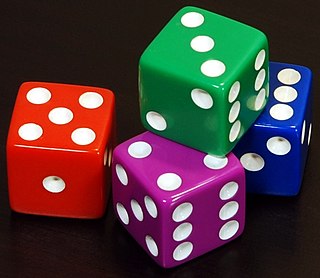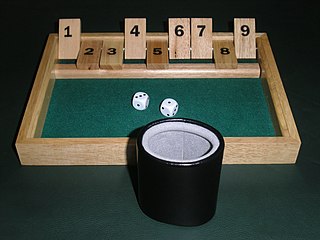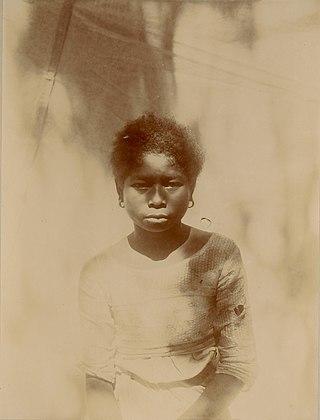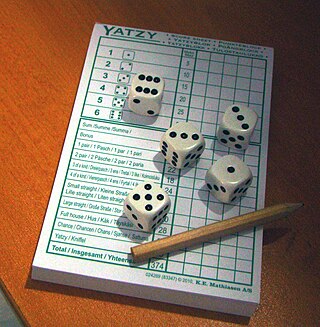
Craps is a dice game in which players bet on the outcomes of the roll of a pair of dice. Players can wager money against each other or against a bank. Because it requires little equipment, "street craps" can be played in informal settings. While shooting craps, players may use slang terminology to place bets and actions.

Dice are small, throwable objects with marked sides that can rest in multiple positions. They are used for generating random values, commonly as part of tabletop games, including dice games, board games, role-playing games, and games of chance.

Dominoes is a family of tile-based games played with gaming pieces. Each domino is a rectangular tile, usually with a line dividing its face into two square ends. Each end is marked with a number of spots or is blank. The backs of the tiles in a set are indistinguishable, either blank or having some common design. The gaming pieces make up a domino set, sometimes called a deck or pack. The traditional European domino set consists of 28 tiles, also known as pieces, bones, rocks, stones, men, cards or just dominoes, featuring all combinations of spot counts between zero and six. A domino set is a generic gaming device, similar to playing cards or dice, in that a variety of games can be played with a set. Another form of entertainment using domino pieces is the practice of domino toppling.
Tien Gow or Tin Kau is the name of Chinese gambling games played with either a pair of dice or a set of 32 Chinese dominoes. In these games, Heaven is the top rank of the civil suit, while Nine is the top rank of the military suit. The civil suit was originally called the Chinese (華) suit while the military suit was called the barbarian (夷) suit but this was changed during the Qing dynasty to avoid offending the ruling Manchus. The highly idiosyncratic and culture-specific suit-system of these games is likely the conceptual origin of suits, an idea that later is used for playing cards. Play is counter-clockwise.

Zambales, officially the Province of Zambales, is a province in the Philippines located in the Central Luzon region. Its capital is Iba, which is located in the middle of the province. Zambales borders Pangasinan to the north and northeast, Tarlac to the east, Pampanga to the southeast, Bataan to the south and the South China Sea to the west. With a total land area of 3,830.83 square kilometres (1,479.09 sq mi), Zambales is the second largest among the seven provinces of Central Luzon after Nueva Ecija. The province is noted for its mangoes, which are abundant from January to April.

Parqués is the Colombian version of a board game in the cross and circle family. The game is described as a "random thinking" game: the moves depend on the roll of the dice but players must consider possible strategies before executing their move. The objective of the game is to advance all the pieces to the end. Once in the safety zone player can use 2 dice until they are one space away from home, where they will then just use one die.

The term Negrito refers to several diverse ethnic groups who inhabit isolated parts of Southeast Asia and the Andaman Islands. Populations often described as Negrito include: the Andamanese peoples of the Andaman Islands, the Semang peoples of Peninsular Malaysia, the Maniq people of Southern Thailand, as well as the Aeta of Luzon, the Ati and Tumandok of Panay, the Mamanwa of Mindanao, and about 30 other officially recognized ethnic groups in the Philippines.

Yahtzee is a dice game made by Milton Bradley. It was first marketed under the name of Yahtzee by game entrepreneur Edwin S. Lowe in 1956. The game is a development of earlier dice games such as Poker Dice, Yacht and Generala. It is also similar to Yatzy, which is popular in Scandinavia.

Shut the box is a game of dice for one or more players, commonly played in a group of two to four for stakes. Traditionally, a counting box is used with tiles numbered 1 to 9 where each can be covered with a hinged or sliding mechanism, though the game can be played with only a pair of dice, pen, and paper. Variations exist where the box has 10 or 12 tiles. In 2018 the game had a renaissance in Liverpool, England, when it became the house game at Hobo Kiosk pub on the Baltic Triangle. It was popularized by DJ duo Coffee and Turntables and became the most played board game in Merseyside for 4 years in a row.
Allan Vito Flores Caidic is a Filipino former professional basketball player in the Philippine Basketball Association. He is considered by many to be the greatest shooter the country has ever produced, thus, earning the moniker, "The Triggerman".

Aeta, Agta and Dumagat, are collective terms for several indigenous Filipinos who live in various parts of the island of Luzon in the Philippines. They are also known as "Philippines Negrito", and included in the wider Negrito grouping of Southeast Asia, with whom they share superficial common physical characteristics such as dark skin tones, short statures, frizzy to curly-hair, and a higher frequency of naturally lighter hair colour (blondism) relative to the general population. They are thought to be among the earliest inhabitants of the Philippines, preceding the Austronesian migrations. Regardless, modern Aeta populations have significant Austronesian admixture and speak Austronesian languages.
Farkle, or Farkel, is a dice game similar to or synonymous with 1000/5000/10000, Cosmic Wimpout, Greed, Hot Dice, Squelch, Zilch, or Zonk. Its origins as a folk game are unknown, but the game dates back to at least the mid-1980s. It has been marketed commercially since 1996 under the brand name Pocket Farkel by Legendary Games Inc. While the basic rules are well-established, there is a wide range of variation in both scoring and play.

San Marcelino, officially the Municipality of San Marcelino, is a 1st class municipality in the province of Zambales, Philippines. According to the 2020 census, it has a population of 37,719 people.

A pub game is one which is traditionally played inside or outside a pub. Most pub games date back centuries and are rooted in village culture. Many derive from older outdoor sports.

Knucklebones, also known as scatter jacks, snobs, astragalus, tali, dibs, fivestones, jacks, or jackstones, among many other names, is a game of dexterity played with a number of small objects that are thrown up, caught, and manipulated in various manners. It is ancient in origin and is found in various cultures worldwide.

The Sambal people are a Filipino ethnolinguistic group living primarily in the province of Zambales and the Pangasinense municipalities of Bolinao and Anda. The term may also refer to the general inhabitants of Zambales. They were also referred to as the Zambales during the Spanish colonial era.

Yatzy is a dice game similar to Yacht and Yahtzee. It is related to the Latin American game Generala and the English game of poker dice. Yatzy is most popular in the Nordic countries.
Traditional Filipino games or indigenous games in the Philippines are games that have been played across multiple generations, usually using native materials or instruments. In the Philippines, due to limited resources for toys, children usually invent games without needing anything but players.There are different kinds of Philippine Traditional Games that are suited for kids, and the games also stand as one of the different culture and/or traditional games of the Philippines. These games are not only fun to play, but these games are also good for you. This is because different games require different skills. These games are also an important part in Filipino culture.
Mariveleño is a Sambalic language. It has around 500 speakers and is spoken within an Aeta community in Mariveles in the Philippines.
Balut is a game of dice, similar to Yahtzee, created by United States soldiers as an alternative to poker, and is a popular pastime of businessmen overseas. The game is named after a delicacy made from the fetal duck egg available in some Southeast Asian countries.













